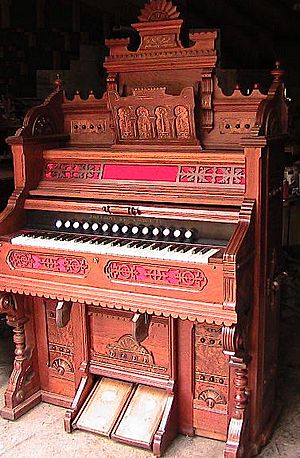Mechanical organ facts for kids

A mechanical organ is a musical instrument that plays itself! Unlike a regular organ that needs a person to play it, a mechanical organ works on its own. Think of it like a very old-fashioned robot musician. These organs often use pipes, just like big church organs. But some also use reeds, which are like the parts inside a harmonium.
Since the 1950s, some mechanical organs have started using electronics to make sounds. They still work using mechanical parts or air pressure (called pneumatics). More recently, from the 1990s, some pipe organs can even be controlled by computers using something called MIDI. This is a way for musical instruments to talk to each other.
Contents
Mechanical Organs: Self-Playing Music Machines
Mechanical organs are fascinating because they can play music without a human performer. They are a big part of music history and show how people found clever ways to automate music. These instruments were popular for entertainment in many places. You might have seen them in old movies or heard about them.
How Mechanical Organs Work
These organs use different methods to store and play music. The earliest ones used large wooden barrels with pins. As the barrel turned, the pins would open valves. This would let air into the pipes, making them play notes. Later, new ways to store music made these organs even more versatile.
A Look at Their History
Originally, the music for mechanical organs was stored on large barrels. These instruments were known as barrel organs. They could only play a few songs. Also, the songs had to be quite short because of the barrel's size. This limited what kind of music they could perform.
Different Ways to Store Music
In the 1890s, a new invention changed things: book music. This was like a giant book made of stiff paper or cardboard. It had holes punched in it. As the book moved through the organ, the holes would tell the organ which notes to play. This meant the music could be much longer. It was also easier to change the music. You just swapped out one "book" for another!
Instead of book music, some mechanical organs use a music roll. This is a long roll of paper with holes punched in it. It works in a similar way to book music. The roll unwinds as the organ plays, and the holes control the notes. Music rolls are still used in some player pianos today.
In Popular Culture
Mechanical organs have appeared in movies and shows. For example, in the 1965 movie The Great Race, a character named Professor Fate pretends to play a mechanical organ. This shows how these unique instruments have captured people's imagination over the years.

